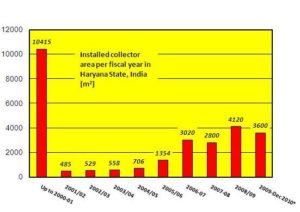25 Years of Different Subsidies in India: an Overview
July 4, 2009Solar City Magarpatta India
Under the new national subsidy scheme of the government of India some more solar cities like Magarpatta in Pune, Maharashtra State, will be realised. The solar thermal market in India has seen a lot of different subsidy models over the years.
Photo: Magapatta City
The Indian government’s Department of Science & Technology initiated its first renewable energy programme in early 1984. To showcase the advantages of solar thermal systems, it initiated a solar thermal energy programme, under which solar systems were installed at important government buildings, such as hospitals and canteens, and subsidised these demonstration projects to 100 %. The government had commissioned about 20 to 25 of these systems, when finding out that the interest in solar systems did not rise. It therefore reduced subsidies in a first step to 70 % and opened it up to target groups from the private sector.
The programme continued until 1990, but subsidies decreased even more. It seemed due to the oversight by the Ministry of New and Renewable Energy (MNRE) in these matters that the solar thermal market did not show any substantial growth. Its bureaucratic procedures for granting capital subsidies and the lack of appropriate financing seemed to deter many potential customers.
In 1991, the government removed the percentage-based subsidy in favour of flat subsidies, ranging between Indian Rupees (INR) 2,000 – 6,000 for a collector of 2 m2. In 1996, states like Maharashtra and Karnataka dropped their subsidy schemes completely. It is interesting to note that it was only after 1996 that the solar water heater market in these states achieved an average annual growth of 50 %.
Banks provided a fantastic foundation for the diffusion of solar technology
For example, in the State of Karnataka, India, there were no more than five manufactures before mid-1990. Even a 30 % capital subsidy on solar water heaters did not attract either new manufacturers or potential clients. The policy change in the mid-1990, from capital subsidy to interest subsidy, completely altered the equation. Within ten years, the number of manufacturers in the state jumped to 60 by 2005. The involvement of the banks (both commercial and rural) ensured the sustainability of the programme – since solar water heaters were now seen like any other consumer product. The vast networks of banks in India set a fantastic foundation for spreading solar technologies.
The MRNE is still subsidising regular interest rates and disburses them through selected national banks. The low-interest loans offer a 2 % rate for individuals, 3 % for institutions and 5 % for commercial entities. Typically, a bank finances 85 % of the project costs during a loan period of 5 years. Commercial enterprises can additionally capitalize on an 80 % depreciation rate.
It has not even been a year since the government of India started to offer a subsidy of 825 INR/m2 for commercial/industrial installations and 1,100 INR/m2 for non-commercial installations, such as hostels, institutions and those that do not benefit from an 80 % accelerated depreciation (under Section 32 of the Income Tax Act) on systems with capacities of 2,500 litres or more per day. Just recently, rates have been revised, in order to encourage the use of solar water heating systems. Non-profit institutions will now receive 1,750 INR/m2 , all other 1,400 INR/m2. The scheme is available until 31 March 2010 , its total budget amounts to INR 495 million. You will find more details about the incentive programme in the database of incentive programmes and the attached document.
Some states are also running long-term incentive programmes for solar thermal
Since the beginning of 2001, the state government of Jharkhand, a state in the north of India, has offered 105 INR/litre for solar water heaters with flat plate collectors and 80 INR/litre for systems with vacuum tube collectors. The installation of such a system typically costs around 150 INR/litre for flat plate collector systems and 115 INR/litre for vacuum tube collector systems. These systems are thus eligible for a nearly 70 % subsidy, independent of the capacity of the system. Since the beginning of the subsidy scheme in 2001, the state government only achieved installations of about 900 m2 in total. It will, however, keep the high subsidy with the goal to reach 4,000 m2 during 2009. What will help are the loans with 0 % in the new guidelines of MNRE.
http://www.jreda.com
The northern state of Haryana is presently offering a 90 % subsidy on solar water heating systems to social institutions that do not benefit from an accelerated 80 % depreciation. A spokesman of the Haryana Renewable Energy Development Agency (HAREDA) said that during 2008-2009, installers set up solar water heating systems of 1,500 m2 for INR 14 million in various social sector institutions, such as women hostels, orphanages, deaf and dumb centres, crèches, old age homes, sports hostels, charitable institutes and natural treatment centres and hostels for students of a specific caste. So far, the state’s programme has already covered 45 institutions. Individual residents and government employees will get a subsidy of INR 5,000 for 100 litre systems and INR 10,000 for 200 litre systems.
http://www.hareda.gov.in


